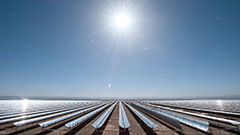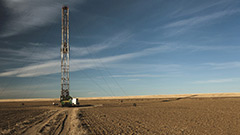Natural disasters are a devastating and unpredictable force. We cannot avert them, but we can minimize their effects – for instance on the power supply using performance materials.
For people living in parts of the world that are at risk from the elements, life is constantly under threat. When natural disasters occur, loss of electricity often intensifies the problem because today we rely so heavily on it. Some of the most important areas of use{bioInclude communication and hospital care. “Maintaining the communication, the electricity supply can be fundamental to a community dealing with a disaster,” said prof. Liz Bentley, meteorologist at Royal Meteorological Society. When four million people are displaced –as happened during the 2013 super typhoon Haiyan – electricity is lost at a time when these facilities are needed most.
Prof. Liz Bentley on the need to adapt to a changing climate.
30 years ago, we would get 150 natural disasters a year. Now that number has doubled.“
Built to resist a typhoon
In July 2014, a 14-force typhoon called “Rammasun” ravaged the Guangdong Province in China. More than 80,000 concrete and metal utility poles collapsed in the powerful typhoon, which not only resulted in heavy property loss, but also brought power failure to large parts of the region. Nevertheless, what’s surprising is that throughout the typhoon attack, a group of plastic utility poles stood firm, and merely “swayed with the wind” amid the gusts of typhoon.
Trail of devastation left behind by Typhoon Rammasun
The secret to “no falling”
The secret to “no falling” utility poles lies in the innovation of the new material. Traditional utility poles mainly rely on their own weight to take root in the ground to gain support. However, when encountering ultra-large typhoons, such pure “rigidity” will lose resistance. Only utility poles with both “rigidity” and “flexibility” can stand firm in the face of a more powerful typhoon. Combining both qualities, the new plastic utility poles are the perfect compound of glass fiber and PU through a filament-winding technique.
A damaged infrastructure and power cuts are a common occurence following heavy winds.
Our climate is changing – it’s about how we adapt to that and move forward.“
Towards a brighter future
To solve the problem of an increased number of natural disasters, we’ve helped develop extremely robust, ultra-light utility poles. When installed, they’re several times stronger than other poles and can withstand severe conditions. These poles address one of the key issues faced by certain regions today. As the climate changes, they provide stability even in hostile conditions.
Naturally, the plastic utility poles resistant to typhoons do not use common plastics. Instead, they use a kind of high-strength and high-flexibility polyurethane (PU) composite material developed by BASF. Compared with the common utility poles, this kind of new utility pole made from Elastolit®, a BASF PU composite material, can improve its wind resistance by 2.5 folds.
Additionally, because the new plastic utility pole is a hollow cylinder, its weight is only less than a quarter of the same type of concrete utility pole. The weight of a common concrete utility pole is generally 1,100 kilograms (2,400 pounds), whereas that of a plastic utility pole is only 250 kilograms (550 pounds), making it possible to be carried and installed by manpower. In terms of installation spacing, this kind of lightweight PU composite utility pole can extend the installation spacing to 120 meters (almost 400 feet), whereas that of common utility poles is 50 meters (160 feet) maximum. Most importantly, however, BASF’s utility poles help make life easier for the people most at risk.








